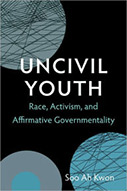Uncivil Youth: Race, Activism, and Affirmative Governmentality

Author: Soo Ah Kwon
Publisher: Duke University Press, Durham, NC, 2013. 169p.
Reviewer: Michael B. Greene | July 2015
Neoliberalism as a 4-Letter Word
Uncivil Youth, though not without merits, is one of the most exasperating books I have ever read. Soo Ah Kwon’s book is based largely upon her ethnographic work as a volunteer staff member and participant observer at a youth collective comprised of six “ethnic” nonprofit organizations in Oakland, California. The collective is the Asian/Pacific Islander Youth Promoting Advocacy Leadership or AYPAL. Kwon’s ethnographic work included interviews and focus groups with staff and youth participants. This work is supplemented by a reasonably good review of the literature on youth-led community organizing. Unfortunately, the book, for the most part, is a single-minded and protracted polemic, arguing that the structural, social, educational, and political changes fought for by youth within a community organizing framework are inherently and severely constrained by the neo-liberal economic and political realities in which the organizing efforts are situated. Given her critique, it is inexcusable that Kwon fails to define neoliberalism or provide any historical or economic analysis of the evolution of this multilayered concept, and fails to provide any systemic empirical evidence to support her point of view. Indeed, she does not cite or discuss any of the key cornerstones of neoliberalism, e.g., Milton Friedman’s economic analyses, laissez-faire policies, Pinochet’s “reforms” in Chile, or the privatization of traditional government functions.
Kwon adopts an argument popular in the late 1960s and early 1970s: change from within the system can only be surface-deep and, ultimately, those who push for radical change ultimately will be coopted into the system that they initially challenged (p. 14). In her view, youth-led community organizing is inherently radical in the sense that it challenges the structural and power underpinnings of multiple oppressive forces. Kwon accurately defines youth-led community organizing as: “a membership of young people involved in direct action, an analysis of power in society, and the recognition of the need for institutional change (quoted from Weiss, 2003)….and relies on the power and leadership of youth acting on issues defined by and affecting young people and their communities, and involves them in the design, implementation, and evaluation of these efforts” (p. 10).
The author pays a great deal of attention to the fact that youth-led community organizing initiatives are largely embedded within not-for-profit social service agencies. These agencies, she argues, cannot reasonably sustain their support of youth-led community organizing efforts for several interrelated reasons: 1) extant funding streams that generally focus almost exclusively on individual change rather than systemic changes to power arrangements that fuel social injustices; 2) the paternalistic ethos that fueled progressive era reformers during the late 19th and early 20th century that still imbues many not-for-profit social agencies; 3) the political backlash in response to the nature of the activism of the youth in their organizing initiatives; and 4) basic bureaucratic challenges within such organizations. These arguments are certainly not without merit, though perhaps overblown in Kwon’s analyses, and certainly must be addressed in order for youth-led organizing efforts to thrive.
The primary problem with Kwon’s analysis, however, is that she provides no guidance or suggestions about how to overcome these obstacles. She downplays and ignores past and current successes (astonishingly, she never once mentions the Student Nonviolent Coordinating Community or SNCC; see Shah, 2011 for additional evidence of success), and she does not appreciate the evolution of youth-led social movements (see for example Deschenes, McLaughin, & Newman, 2008). Moreover, her arguments are bogged down in nearly incomprehensible jargon as illustrated by the following quotation:
In the current moment of neoliberalism, the will to empower and be empowered is exercised as a mode of power intended to regulate and enable young people by encouraging them to participate in nonprofit programs meant to protect them from the risks of their environment and also from the threat of becoming “at risk”…it becomes apparent that a citizen-subject’s failure to act or help him or herself justifies state intervention. It also legitimizes such individual’s criminalizing…and punishment (pp. 56-57).
Ironically despite her arguments to the contrary, Kwon provides several enlightening and positive examples of analyses by and actions of youth involved in AYPAL’s organizing efforts in challenging immigration and criminal/juvenile justice policies; and she illuminates the rarely discussed racial stereotyping within youth of color movements, particularly in relation to Asian youth (see Chapter 4). She makes important distinctions between authentic community organizing and traditional civil engagement strategies (as in get-out-the-vote drives and voluntary community service, such as clean-up projects). And contrary to her philosophical perspective, she even allows for some sanguine and supportive statements on the effectiveness of youth led social organizing, e.g., “AYPAL {youth} worked within the institutional constraints of promoting individual youth behavioral outcomes while remaining rooted in the social justice aims of youth organizing” (p. 70).
Additionally, Kwon is careful not to blame or “victimize” the youth themselves and consistently conveys her respect for the young people engaged in community organizing initiatives. Similarly, she acknowledges additional benefits to the work young people at AYPAL did in researching the history and inequities of immigration policies, particularly with regard to Cambodian refugees: “the campaign gave many young people the opportunity to connect with their parents and other family members in meaningful ways” (p. 115).
Furthermore, Kwon provides an informative discussion of the interrelatedness of youth-led community organizing and the positive youth development movement that emphasizes strengths, competencies and the importance of youth engagement and leadership. While some writers have argued that an irresolvable divide exists between the two (see also Ginwright, 2003), she persuasively argues that the goals of each are complementary rather than contradictory. She even provides a good laugh in her critique of mainstream multiculturalism — one that embraces the 4 Fs: “food, fashion, famous people, and festivals” (p. 93). She then provides examples of how art and theater can be productively used in the context of youth organizing efforts.
Overall, for a more thorough understanding of the dynamics, promise, and limitations of youth-led community organizing, I would recommend Delgado and Staples’ (2008) comprehensive review and analysis as well as the ongoing newsletters and publications of the Funders Collaborative on Youth Organizing, some of which Kwon cites (http://www.fcyo.org).
References
Delgado, M. & Staples, L. (2008). Youth-led community organizing: Theory and Action. New York: Oxford University Press.
Deschenes, S., McLaughin, M, Newman, A. (2008). New Directors for youth development. San Francisco: Josey-Bass.
Ginwright, S. (2003). Youth organizing: Expanding the possibilities for youth Development. Occasional Series on Youth Organizing, No. 3, Funders Collaborative on Youth Organizing.
Shah, S. (2011). Building transformative leadership. Occasional Series on Youth Organizing, No. 11, Funders Collaborative on Youth Organizing.
Weiss, M. (2003). Youth rising. Oakland: Applied Research Center.


